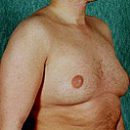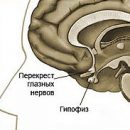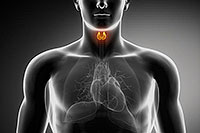Treatment of hypoparathyroidism depends on the severity of the attack. The main means for the relief of the attack of Tetania are a solution of calcium chloride or gluconate, as well as parathyroidid. In the intergreacarial period, vitamin D preparations are prescribed in combination with calcium.
Content
Methods of treatment of hypoparatiroids
To relieve acute attack of Tetania, depending on the severity of the attack, 10-50 ml of a 10% solution of chloride or calcium gluconate (more often 10-20 ml) are injected intravenously. Inserting calcium preparations should be slowly (5 ml of the drug for 3-5 minutes), since the rapid introduction is possible collapse and fibrillation of the ventricles of the heart. The effect of the drug is manifested at the end of the injection. Depending on the need for calcium preparations are injected intravenously 3-4 times a day. After the administration of calcium preparations for the prevention of totanium attacks subcutaneously or intramuscularly administered, if necessary, 40-100 units of pararatyroididine. Paratyroidin - extract of the rest of the cattle of cattle, contains in 1 ml of 20. Therapeutic effect after its administration occurs after 2-3 hours and lasts 20-24 hours. The maximum increase in the content of calcium in the blood after the administration of the drug is observed after 18 hours. With prolonged administration of parathyroidism, anaphylactic reaction and resistance may develop due to the formation of immune antibodies to the parathgormon, which limits the possibilities for its use during the intercreant period.
With laryngupphasis, intubation or tracheotomy are carried out.
In the intercreant period, vitamin D preparations are prescribed in combination with calcium preparations in the form of its salts (chloride, lactate and gluconate). To improve the absorption of calcium, the intestine and the reabsorption of calcium in the renal channels use Ergocalciferol (vitamin D3) in alcohol (1 ml contains 200,000 units or oil solutions with a content of 1 ml of 25,000, 50,000 or 200,000 me; 1 drop of vitamin D alcohol solution contains about 4000 me, and oil - respectively 625, 1250 or 5000 me. In the acute period, vitamin D2 is prescribed depending on the need for 200,000-400,000 me per day. In the interconception period, the supporting dose of the drug is 25,000-50,000 me per day. In the treatment of vitamin D, systematically 1-2 times a month investigate the calcium content in the blood and its selection with urine, and also monitor the kidney function (danger of nephroalcinosis and nephrolity). The most effective preparations of vitamin D3 - Oxycholecalciferol, oxidevit, calcidiol. In the acute period, the daily dose of vitamin D3 may be 2-4 μg per 2 reception, supporting - 0.5-1 μg / day. The maximum biological effect of these drugs is manifested in 3-6 days, and vitamin D2 - after 2-4 weeks. Instead of vitamin D2, the drug is used by the drug of the near-shaped glands - 0.1% oily solution of the dihydroitacterol, which is close to the vitamin D2 for the chemical structure; 1 ml (40 drops) of the oil solution contains 1 mg of dihydroitacterol. Takhistin takes inside after eating. In the acute period, 1-2 mg (40-80 drops) are prescribed every 6 hours, followed by a decrease in dose, depending on the state of the patient every 2 days per 2 mg. Supporting dose individual and is 0.5-2 mg per day (20-80 drops). DihydroTrohisterol contributes to the mobilization of calcium from bones, the absorption of calcium in the intestine and the removal of phosphorus with urine. The maximum biological effect of dihydroitacterol, as well as vitamin D2, is manifested in 2-4 weeks.
Calcium preparations are prescribed in the intercreant period of 1-2 g per day after meals. To increase the content of calcium in the blood and decrease in it, the level of phosphorus is prescribed inside aluminum hydroxide in the form of a 4% suspension of 20-30 ml per day. Aluminum Hydroxide binds phosphates and delays their suction from the gastrointestinal tract. Appointed soothing and antispasmodic agents (bromides, luminal, chlororalhydrate in the enema, papaverine). With alkalosis, ammonium chloride is shown inside after eating 3-7 g per day.
Treatment of hypoparatyroid is carried out under the control of calcium, phosphorus and magnesium in the blood. In hypomagnesiamia, a 25% solution of magnesium sulfate is prescribed 10-20 ml intramuscularly.
Create calcium depot in the body by adding to the muscle of canned bone. Conducting work on transplantation of nearby.
In case of pseudogipoparathyroidism for the relief of hypocalcemia, drugs of vitamin D and calcium are used. Paratyroidin in this disease is ineffective due to resistance to it «targets».
For approximate judgment on the content of calcium in the blood, Sulkovich's sample is used.
Prevention of disease development
The prophylaxis of the hypoparatyase is in a neat attitude towards the restoration of the winding glands during the operation on the thyroid gland, as well as in preventing complications (spikes, infiltrates), violating blood supply after surgery.
 In order to avoid the development of hypoparatiosis in patients with recurrent toxic goiter, treatment with radioactive iodine is recommended instead of surgical intervention. Preventive measures should also be aimed at early detection of increased neuromuscular excitability in patients after the operation on the thyroid gland, followed by immediate rational specific therapy. The prevention of infections and intoxication, damaging nearby glands, as well as factors provoking the development of acute hypocalcemic crises in patients with chronic hypoparathyroidism. For the prevention of Tetania diet patients with hypoparathiosis should be rich in calcium, magnesium and poor phosphorus (vegetables, fruits, milk, dairy products). The use of products containing vitamin D2 (cod liver, fishe fat, egg yolk, butter). During periods of exacerbation of food, meat completely exclude, as it enhances the manifestation of Tetania.
In order to avoid the development of hypoparatiosis in patients with recurrent toxic goiter, treatment with radioactive iodine is recommended instead of surgical intervention. Preventive measures should also be aimed at early detection of increased neuromuscular excitability in patients after the operation on the thyroid gland, followed by immediate rational specific therapy. The prevention of infections and intoxication, damaging nearby glands, as well as factors provoking the development of acute hypocalcemic crises in patients with chronic hypoparathyroidism. For the prevention of Tetania diet patients with hypoparathiosis should be rich in calcium, magnesium and poor phosphorus (vegetables, fruits, milk, dairy products). The use of products containing vitamin D2 (cod liver, fishe fat, egg yolk, butter). During periods of exacerbation of food, meat completely exclude, as it enhances the manifestation of Tetania.
To activate vitamin D biosynthesis in the body of patients with a chronic form of hypoparatyase, can be recommended moderate ultraviolet irradiation or short solar baths.
Systematic control of calcium and phosphorus content in the blood is carried out: in patients with first detected Tetania and during the change of drugs for the selection of adequate doses - 1 time in 7-10 days, and with a stable course of the disease - 1 time in 4-6 months. Systematic observation of the eyepiece (the possibility of cataracting). Radiography of the skull and other bones spend on clinical indications.









